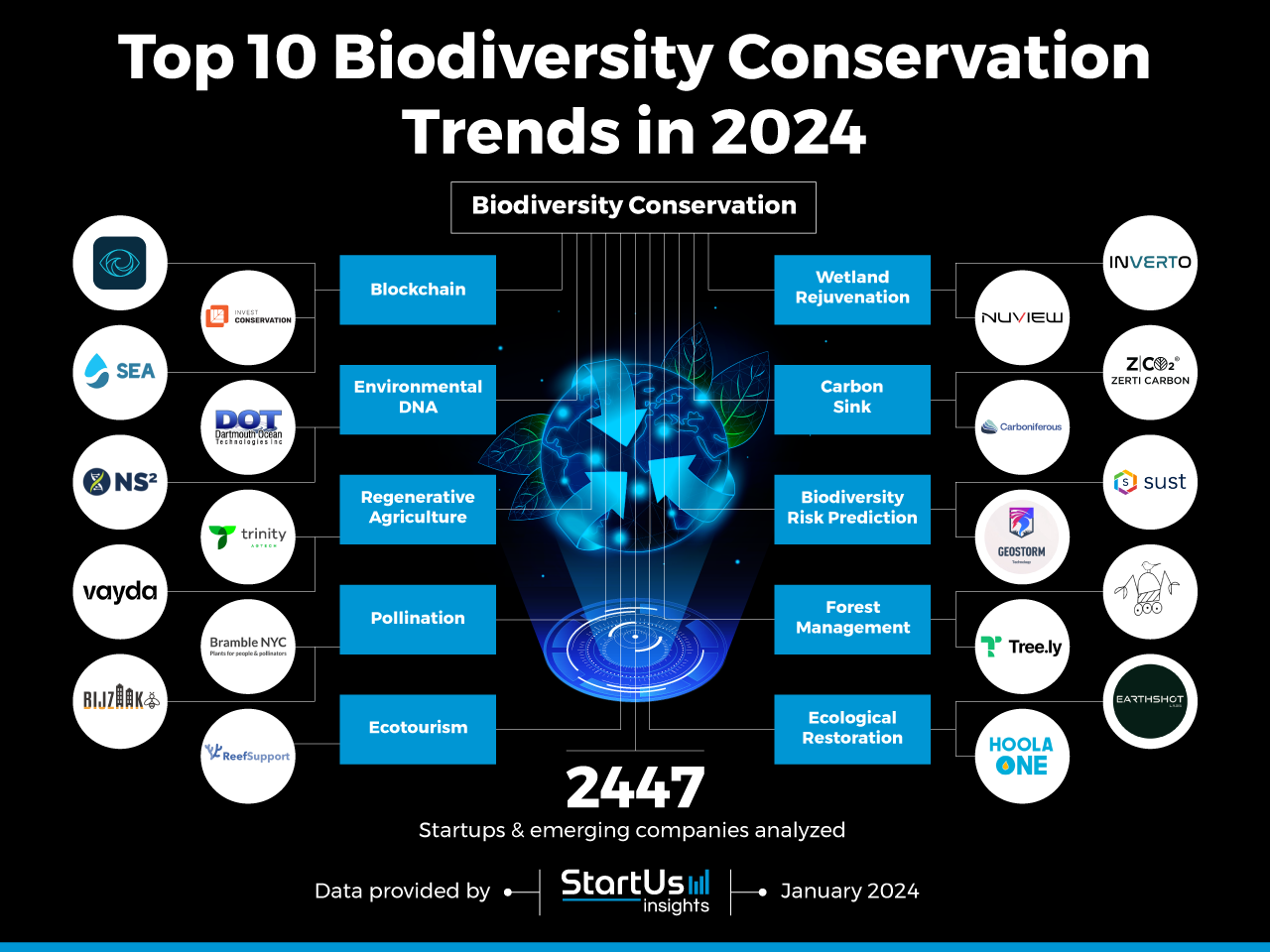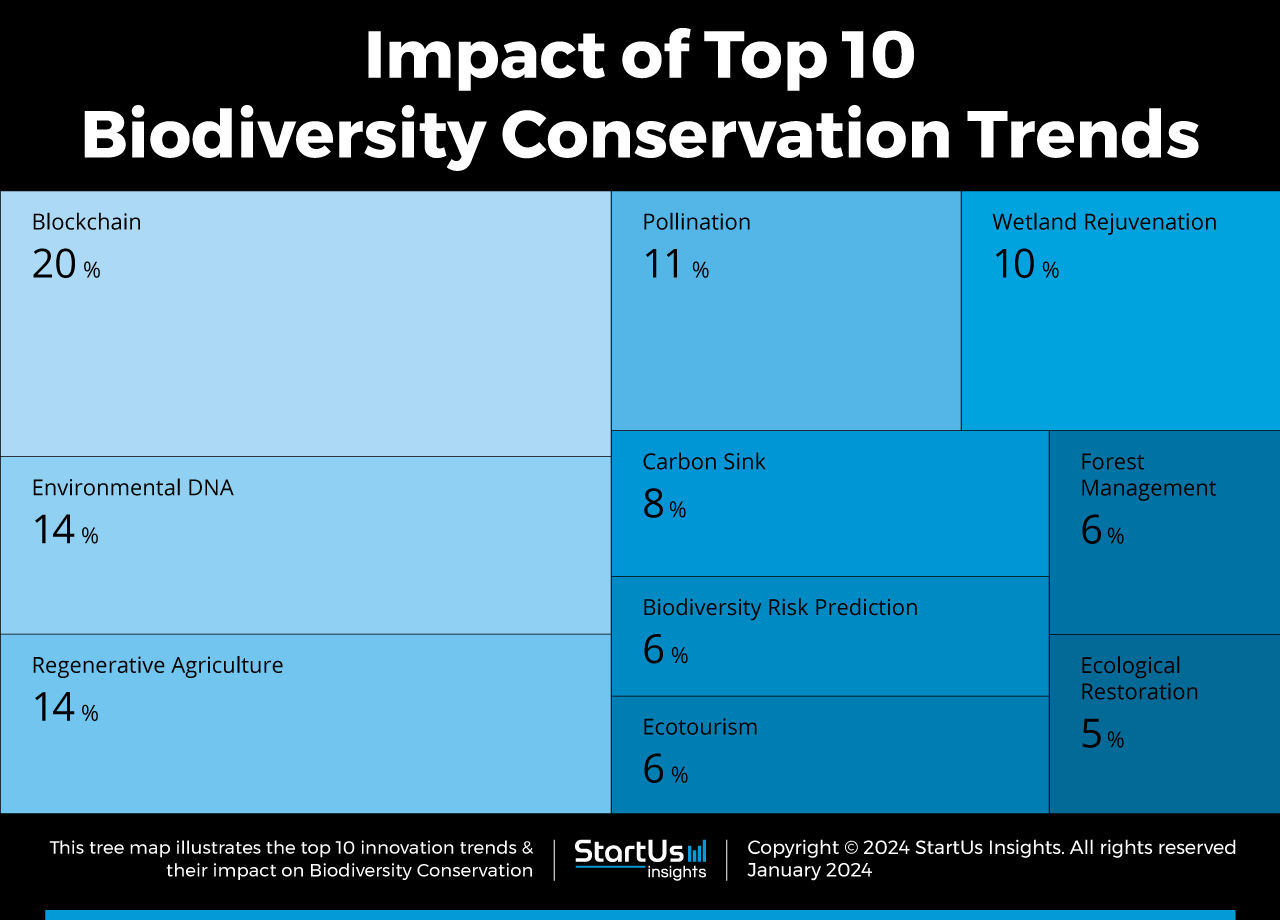Accelerate Productivity in 2025
Reignite Growth Despite the Global Slowdown
In an era where the balance of our planet’s ecosystems faces unprecedented challenges, the conservation of biodiversity has never been more critical. This article delves into the latest trends in biodiversity conservation, exploring innovative strategies and cutting-edge research to protect the rich tapestry of life on Earth. From the integration of technology in wildlife monitoring to community-driven conservation initiatives, we examine how these approaches are reshaping our efforts to safeguard the diversity of species and ecosystems. These trends include blockchain, regenerative agriculture, wetland rejuvenation, and more.
Top 10 Biodiversity Conservation Trends in 2024
- Blockchain
- Environmental DNA (eDNA)
- Regenerative Agriculture
- Pollination
- Wetland Rejuvenation
- Carbon Sink
- Biodiversity Risk Prediction
- Ecotourism
- Forest Management
- Ecological Restoration
Innovation Map outlines the Top 10 Biodiversity Management Trends & 20 Promising Startups
For this in-depth research on the Top Trends in Biodiversity Conservation, we analyzed a sample of 2447 global startups & scaleups. This data-driven research provides innovation intelligence that helps you improve strategic decision-making by giving you an overview of emerging technologies in the biodiversity management industry. In the Biodiversity Conservation Innovation Map, you get a comprehensive overview of the innovation trends & startups that impact your company.
These insights are derived by working with our Big Data & Artificial Intelligence-powered StartUs Insights Discovery Platform, covering 3 790 000+ startups & scaleups globally. As the world’s largest resource for data on emerging companies, the SaaS platform enables you to identify relevant technologies and industry trends quickly & exhaustively.
Tree Map reveals the Impact of the Top 10 Biodiversity Conservation Trends in 2024
Based on the Biodiversity Conservation Innovation Map, the Tree Map below illustrates the impact of the Top Biodiversity Management Trends in 2024. Blockchain ensures secure and transparent tracking of conservation efforts while eDNA offers a non-invasive method for monitoring ecosystems. Additionally, regenerative agriculture promotes biodiversity and efforts to improve pollination are vital for ecosystem sustenance.
Businesses and conservationists leverage wetland rejuvenation and ecological restoration to restore degraded ecosystems while risk prediction solutions allow them to ensure preemptive conservation. Carbon sinks also function like forests and absorb atmospheric CO2. Ecotourism further fosters sustainable interactions while tech-driven forest management balances ecological needs with resource use.
Global Startup Heat Map covers 2447 Biodiversity Management Startups & Scaleups
The Global Startup Heat Map below highlights the global distribution of the 2447 exemplary startups & scaleups that we analyzed for this research. Created through the StartUs Insights Discovery Platform, the Heat Map reveals high startup activity in Western Europe and the US, followed by India.
Below, you get to meet 20 out of these 2447 promising startups & scaleups as well as the solutions they develop. These biodiversity management startups are hand-picked based on criteria such as founding year, location, funding raised & more. Depending on your specific needs, your top picks might look entirely different.
Interested in exploring all 2400+ biodiversity management startups?
Top 10 Global Biodiversity Conservation Trends in 2024
1. Blockchain
Blockchain offers a transparent and secure way to track and manage environmental data. Its decentralized and immutable nature ensures reliable monitoring of species, ecosystems, and conservation funds. This technology facilitates the creation of tamper-proof records for tracking wildlife trade, managing protected areas, and monitoring the impact of conservation projects.
Additionally, blockchain enables fundraising through cryptocurrencies and ensures accountability in resource allocation. By enhancing data integrity and fostering trust among stakeholders, blockchain optimizes biodiversity conservation efforts.
Ocean Eye aids in Marine Biodiversity Conservation
Ocean Eye is a Finnish startup that develops a marine biodiversity conservation platform. It facilitates micropayments from sightings of marine life to coastal communities. The platform offers transparent financial incentives to support effective conservation efforts and climate adaptation.
Additionally, an NFT collection was launched to support the organization’s work. The platform also allows full financial transfers for addressing issues like wildlife trafficking and overhunting of marine species.
InvestConservation offers Tokenized Conservation Projects
Swiss startup InvestConservation uses blockchain to make biodiversity investable. The startup tokenizes high-value conservation projects, with each token linked to a hectare of forest land.
The startup also ensures that the forest remains intact by monitoring it through satellite auditing. Investors get the ownership of carbon and biodiversity credits, and the investment goes directly to forest owners to protect nature through secure and transparent transactions.
SEA provides a Utility Token for Environmental Investments
UK-based startup SEA implements a utility token, SEA BSC or $SEA, to support its ocean ecosystem restoration projects. Each token transaction triggers a tax, part of which funds environmental organizations. This system encourages sustainable investments and aligns economic incentives with conservation goals. The project creates a deflationary currency to support biodiversity.
2. Environmental DNA
Environmental DNA provides a non-invasive method to monitor and assess ecosystems. By analyzing DNA fragments found in the environment, such as in water or soil, scientists identify and quantify species present in an area without physically observing them.
This approach provides a more comprehensive understanding of biodiversity and ecosystem health, facilitating better-informed conservation strategies. eDNA is especially useful for detecting rare or elusive species and monitoring aquatic environments, making it a valuable tool in the ongoing effort to preserve global biodiversity.
Dartmouth Ocean Technologies enables Autonomous eDNA Sampling
Canadian startup Dartmouth Ocean Technologies (DOT) develops an autonomous eDNA sampler that detects biological genomic signatures underwater. The sampler unit operates automatically using a preconfigured mission profile. The sampler’s compact design facilitates the deployment of diverse vessels and platforms, making it compatible with different sampling and environmental conditions.
It is used by marine biologists and researchers to study marine plant diversity. This technology provides a convenient solution for collecting environmental DNA data to study and preserve marine biodiversity.
Nucleic Sensing Systems facilitates Real-time eDNA Monitoring
US-based startup Nucliec Sensing Systems (NS2) provides real-time genetic abundance data through its eDNA tracker. The tracker works autonomously to monitor concerned species and delivers real-time environmental DNA data remotely through the cloud. It is designed to be deployed wherever required and can withstand any climate circumstance.
The tracker further combines autonomous sampling with geospatial data to monitor any biological changes. This information assists in monitoring, predicting, and dealing with biological changes, such as pathogens, parasites, or other invasive species, that may disturb the biodiversity of that specific ecosystem.
3. Regenerative Agriculture
Regenerative agriculture is gaining momentum as a key trend in biodiversity conservation. It focuses on farming practices that restore soil health, enhance water retention, and increase biodiversity. This approach goes beyond merely sustaining the land, actively working to rejuvenate and improve it.
By integrating techniques like crop rotation, cover cropping, reduced tillage, and agroforestry, regenerative farming boosts crop yields and creates habitats for various species. This practice plays a significant role in combating climate change and preserving ecosystems, making it a crucial component in the broader environmental conservation movement.
Trinity Agtech provides a Biodiversity Calculator for Regenerative Farming
UK-based startup Trinity Agtech provides a tool, Sandy, that calculates and maintains farm diversity. Once a farmer marks the exact farm location on the map, its framework generates the farm biodiversity report. The tool then suggests farming practices to improve biodiversity scores, aiming to conserve concerned species while giving optimal solutions to farmers.
Vayda implements a Regenerative Approach to Biodiversity Improvement
US-based startup Vayda implements a customized approach to regenerative farming. The approach comprises a balanced mixture of regenerative practices considering local conditions, risk factors, market reach, and miscellaneous factors corresponding to farm value.
Vayda also applies precision agriculture using satellites, drones, and in-field sensors to maintain agricultural precision with traditional farming methods. By maximizing farm yield and ensuring improvement in soil, water, climate, and farm biodiversity, Vayda improves farmer livelihoods and biodiversity.
4. Pollination
The role of pollination in biodiversity conservation is gaining attention as a critical ecological process. Pollination, primarily driven by bees and other pollinators, is essential for the reproduction of many plants and the maintenance of healthy ecosystems. Conservation efforts are now focusing on protecting and enhancing pollinator populations, recognizing their indispensable role in sustaining biodiversity.
These efforts include creating pollinator-friendly habitats, reducing pesticide use, and fostering diverse plantings. By ensuring the health and diversity of pollinator species, companies support the broader goal of maintaining and enhancing global biodiversity.
Bramble provides a Micro-Landscaping Solution
US-based startup Bramble develops a micro-landscaping solution to keep pollinator biodiversity and ecological balance at the center. The startup creates gardens for urban areas so that pollinators survive even in urban sites with less vegetation. The project includes micro gardens, container gardens, rewilding backyards, and tree beds.
Bijaak develops Urban Beekeeping Solutions
Dutch startup Bijaak provides urban beekeeping solutions to preserve biodiversity. It installs and maintains beehives on the roof or indoor gardens of government and commercial buildings. The beekeeper of the startup visits the building to suggest the best site for the beehive.
After installation, the beekeeper does regular inspection visits regarding the health of the beehive. Bijaak also provides suggestions about bee-friendly flowers and workshops about bees. This boosts pollinators’ biodiversity organically which is essential for overall flora-fauna biodiversity.
5. Wetland Rejuvenation
Wetlands have been adversely affected by human activities like agriculture, urban development, and pollution. Wetland rejuvenation processes typically include restoring natural water flows to re-establish the wetland’s hydrology, reintroducing indigenous plant and animal species, and removing invasive species and contaminants.
These rejuvenation efforts enhance biodiversity by providing habitat for a diverse range of species. This way, wetland rejuvenation improves water quality through natural filtration processes, sequestering carbon, and mitigating flood risks. The emphasis on wetland rejuvenation reflects a growing awareness of the critical role these ecosystems play in maintaining ecological balance.
Inverto provides Scalable Nature-based Wetland Restoration
Swiss startup Inverto offers nature-based solutions using drones to restore coastal wetlands and agricultural lands more efficiently. The startup develops automated systems for mangrove planting, sampling, site selection, and monitoring. Inverto also has technology for precisely releasing beneficial insects like fruit flies and ladybugs, as well as mosquitoes and tsetse flies.
Nuview simplifies Wetland Monitoring
US-based startup Nuview provides a space-based LiDAR wetland monitoring and restoration system. It has three major components – digital surface models (DSMs), LiDAR point cloud, and digital terrain models (DTMs). These technologies represent the earth’s surface in 3D with high-resolution comprising both natural and man-made terrains.
This facilitates identifying wetland boundaries and health discreetly. The startup’s solution also guides optimized wetland restoration and efficient land-use planning to protect biodiversity. This benefits conservationists and local communities to monitor and plan wetland conservation and restoration.

6. Carbon Sinks
Carbon sinks as a trend in biodiversity conservation are gaining prominence due to their role in mitigating climate change. These natural systems absorb and store more carbon dioxide than they release, thereby reducing the amount of CO2 in the atmosphere. Forests, oceans, and wetlands are prime examples.
Conservation strategies now increasingly focus on preserving and enhancing these carbon sinks. This includes efforts like reforestation, sustainable forest management, and protecting oceanic and wetland ecosystems. By maintaining and increasing the capacity of these natural carbon sinks, biodiversity conservation efforts play a crucial role in addressing global climate change challenges.
Zerti Carbon provides Blockchain-certified Carbon Sink Solutions
Finnish startup Zerti Carbon uses blockchain to create and manage carbon sinks in forests. It connects forest owners with buyers of CO2 captured by the trees. The startup’s app allows users to scan and measure the carbon sequestration of each tree. It benefits the environment by reducing carbon emissions and biodiversity loss.
The startup’s solution benefits forest owners by generating income and incentives for sustainable forestry. It benefits buyers by offsetting their carbon footprints. The startup also adopts a climate-smart forestry approach that protects biodiversity and forest health of European forests.
Carboniferous enables Anoxin Biomass Carbon Sequestration
US-based startup carboniferous preserves biomass in anoxic basins for natural carbon sequestration. It explores and utilizes hypersaline, anoxic basins as carbon sinks. The startup works with scientific organizations to measure, report, and verify carbon removal.
This process benefits the environment as Carboniferous prevents the release of carbon dioxide and methane into the atmosphere. The startup also sources its biomass sustainably, avoiding deforestation and land degradation. This is beneficial to the local community and overall biodiversity.
7. Biodiversity Risk Prediction
Biodiversity risk prediction solutions leverage data analytics and predictive modeling to foresee and mitigate threats to biodiversity. This approach involves analyzing environmental, biological, and anthropogenic data to predict potential risks to ecosystems and species. By anticipating changes and identifying vulnerable areas, conservationists implement proactive measures.
One such example is the use of satellite imagery to monitor deforestation and habitat loss, allowing for timely interventions. Employing climate models to predict the impact of climate change on specific species and ecosystems and genetic analysis for understanding population genetics are other applications. These predictive tools and models enable conservationists to take preemptive actions and protect vulnerable species and habitats.
Sust Global delivers Climate Risk Analytics
US-based startup Sust Global predicts and analyzes climate risk. Its Climate Risk Analytics Dashboard combines machine learning and AI to convert complex climate and satellite data into clear insights. It shows wildfires, floods, cyclones, water stress, drought, and sea level rise data.
The explorer assists businesses and government agencies in planning sustainable practices by showing the environmental risks and their impacts on assets, infrastructure, and networks on the earth. The startup provides climate risk data APIs and integrations for individual or startup projects regarding climate-awareness products and applications.
Geostorm enables Extreme Weather Forecasting
Israeli startup Geostorm offers solutions for biodiversity risk prediction caused by natural disasters and climate action failures. The forecasting technology of its system utilizes ALFA and ML methods for almost instantaneous prediction.
The startup’s technology also quickly recognizes hazardous meteorological formations. The system benefits stakeholders, such as government, businesses, communities, conservationists, researchers, and tourists, who depend on or affect biodiversity, and plan preventive measures against natural disasters.
8. Ecotourism
Ecotourism represents a sustainable travel approach focusing on the preservation and appreciation of natural environments. This form of tourism fosters environmental awareness and respect among tourists. It often involves visiting pristine, fragile, and relatively undisturbed natural areas, making it a powerful tool for educating travelers about the importance of biodiversity and environmental conservation.
An essential aspect of ecotourism is its emphasis on responsible travel practices that benefit local communities and contribute to the conservation of natural habitats. By channeling a portion of the revenue generated back into conservation efforts and community development, ecotourism creates a symbiotic relationship between tourism and nature conservation.
Reef Support develops Open Coral AI
Dutch startup Reef Support utilizes AI to assess and protect coral reef biodiversity. Its Open Coral AI tool allows eco-tourists to upload and label coral data, which trains the AI model. The divers can book diving trips for coral monitoring through the startup’s online portal.
The portal allows users to access and research their labeled data. The AI model facilitates monitoring coral sites and safeguards coral reef’s biodiversity from unsustainable tourism.
9. Forest Management
Forest management emphasizes sustainable practices that maintain and restore the ecological integrity of forested areas. By implementing strategies like controlled logging, reforestation, and habitat restoration, forest management preserves the intricate balance of flora and fauna that constitute forest ecosystems. A key aspect of this trend is the recognition of forests as critical reservoirs of biodiversity. They provide habitat for a vast array of species, many of which are endemic or threatened.
Effective forest management involves monitoring biodiversity, assessing the impacts of human activities, and implementing measures to mitigate these impacts. Moreover, forest management considers the ecological connections between forests and other ecosystems, recognizing the importance of landscape-scale conservation.
Bird Habitat Bot implements Native Plantation Approach for Forest Management
US-based startup Bird Habitat Bot develops a robotic system that detects, removes, and replaces invasive flora in the ecosystem. The startup develops a prototype that, based on a drone and a convolutional neural network, identifies and eradicates invasive plants.
The startup also runs educational programs to inform and educate citizen scientists to identify invasive and native species. Planting native species promotes genetic diversity and provides new food and income sources for local communities. It also improves soil and water quality for better agricultural yield.
Treely connects Forest Owners and Conservation Teams
Austrian startup Treely links up forest owners with companies to financially assist forest owners in managing forests effectively. The platform provides an open opportunity for both individuals and companies to support climate support projects by purchasing carbon credits. The carbon credits are based on the “SILVACONSULT Forest Carbon Standard” methodology.
Forest owners receive credits for their forest management efforts, generating extra revenue and enhancing the ecosystem. The startup conducts climate protection projects in European forests, collecting funds via its platform. This benefits investors, forest owners, and biodiversity.
10. Ecological Restoration
Ecological restoration efforts focus on repairing and revitalizing ecosystems that have been degraded, damaged, or destroyed. They aim to restore the health, integrity, and sustainability of ecosystems, often attempting to return them to their pre-disturbance states. Ecological restoration includes active interventions such as replanting native vegetation, removing invasive species, and rehabilitating natural processes like water flow and fire regimes.
A central tenet of ecological restoration is enhancing biodiversity by reestablishing habitats that support a wide range of species, including those that are rare or endangered. This approach benefits individual species and also strengthens ecosystem services like water purification, climate regulation, and soil fertility.
Earthshot simplifies Carbon Project Financing
US-based startup Earthshot offers a platform for developing and financing nature-based carbon projects. Its native platform provides carbon development and scientific predictive analytics for carbon projects.
The platform identifies the potential project area and provides pre-feasibility and feasibility study reports for REDD+, ARR, and IFM projects. Earthshot’s platform enables sustainable use of resources and biodiversity conservation as well as improves ecological restoration monitoring, benefiting both investors and conservationists.
Hoola One aids in Plastic Pollution Management
Canadian startup Hoola One offers ecological restoration solutions by managing plastic pollution. Its plastic removal technologies provide customized solutions to clean plastic-polluted areas. One of their solutions is HO Micro, which is a decantation technology that collects plastics from 0.001 to 7.5 cm.
The machine is capable of working on any type of soil and can extract plastics from depth. The other variants HO Wrack and HO Backpack come with different plastic collection capacities. The startup also provides customizable cleaning solutions for diverse sites affected by macro or microplastics. This technology facilitates a plastic-free ecosystem that supports healthy biodiversity and a clean environment for all.
Discover all Biodiversity Conservation Trends, Technologies & Startups
As we explore the diverse trends in biodiversity conservation, from the innovative use of technology in eDNA analysis to the community-driven approaches of ecotourism, it’s clear that the fight to preserve our planet’s rich biodiversity is evolving. Each trend, with its unique approach and application, contributes to a more comprehensive and effective conservation strategy. This journey through the latest methods and practices in biodiversity conservation highlights ingenuity and dedication as well as underscores the collective responsibility we share.
The Biodiversity Management Trends & Startups outlined in this report only scratch the surface of trends that we identified during our data-driven innovation & startup scouting process. Identifying new opportunities & emerging technologies to implement into your business goes a long way in gaining a competitive advantage.





![Explore the Top 10 Waste Management Industry Trends & Innovations [2025]](https://www.startus-insights.com/wp-content/uploads/2025/06/Waste-Management-Industry-Trends-SharedImg-StartUs-Insights-noresize-420x236.webp)




